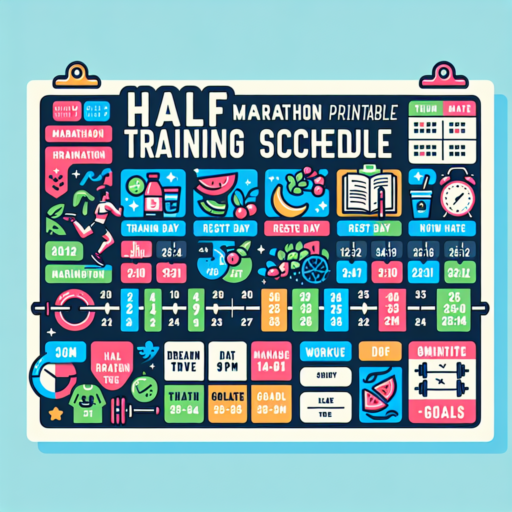How to train for speed for a half-marathon?
Training for speed in a half-marathon is a multifaceted process that requires a tailored approach, blending various types of workouts to incrementally improve your pace. A strategic plan, focusing on endurance, strength, and speed work, is essential for any runner looking to shave minutes off their current half-marathon time.
Integrate Interval Training
One effective method to increase your speed is through interval training. This involves running short distances at a high intensity followed by a period of low intensity or rest. For example, 1-minute sprints followed by 2 minutes of jogging. Interval training improves both aerobic and anaerobic capacity, critical components for enhancing your half-marathon race pace.
Incorporate Tempo Runs
Incorporating tempo runs into your training regimen can significantly impact your ability to maintain a faster pace over the duration of a half-marathon. A tempo run, or a comfortably hard run, pushes you to find your lactate threshold, or the point at which your body begins to fatigue at a rapid rate. Gradually increasing the length of your tempo runs can enhance your endurance at high speeds.
Strengthening Exercises
A robust strength training program can also contribute to your speed development. Focus on exercises that build your core and leg strength, such as squats, lunges, and planks. Strengthening your core and lower body will improve your running economy, allowing you to run faster with less effort.
Should you do sprints when training for a half-marathon?
Incorporating sprints into your half-marathon training routine can seem counterintuitive at first. After all, a half-marathon is a test of endurance, pacing, and consistent rhythm over a considerable distance. However, adding sprints to your regimen offers several significant benefits that can enhance your overall performance and even improve your half-marathon time.
The Benefits of Sprints for Endurance Runners
- Improved Running Economy: Sprints increase your running efficiency, teaching your body to use oxygen more effectively during long-distance events.
- Increased Speed and Power: Sprint training develops fast-twitch muscle fibers, giving you the ability to push harder and increase your speed in the final stages of a race.
- Better Fatigue Resistance: By simulating the high-intensity efforts of the race’s end, sprints help your body adapt to the stress, improving your endurance and resistance to fatigue.
While the benefits are clear, it’s crucial to integrate sprints carefully into your training routine to prevent injury and ensure they contribute positively to your half-marathon preparation. Balancing sprint sessions with longer, slower runs and rest days is key to a holistic and effective training program.
No se han encontrado productos.
What pace should I run easy for half-marathon training?
Finding the perfect pace for easy runs during your half-marathon training is crucial for building endurance without overexerting yourself. Easy pace is often misunderstood, with many runners pushing too hard on what should be their recovery or long, slow distance days. The key is to target a pace that feels manageable and allows for conversation without gasping for breath. This is typically between 60 to 70% of your maximum heart rate, which, for most runners, translates to about 1 to 2 minutes slower per mile than your current half marathon race pace.
Identifying Your Easy Run Pace
To accurately identify your easy run pace, consider using recent race times or performing a time trial. From there, you can use a running calculator to estimate your appropriate training paces. This method ensures that your easy days are truly easy, helping your body to recover and adapt to the rigors of training. Remember, the goal of easy runs is to build endurance and aerobic capacity without accumulating fatigue, setting the stage for successful speed work and race days.
Benefits of Sticking to the Easy Pace
Adhering to an easy pace for certain runs can bring a multitude of benefits, including improved cardiovascular efficiency, better fat utilization, and enhanced recovery. By allowing your body the time to recover with easier-paced runs, you’re more likely to avoid injury and burnout. Additionally, this disciplined approach to pacing helps develop mental toughness and patience, crucial qualities for tackling the half-marathon distance.
What pace interval training for half-marathon?
Training for a half-marathon involves a blend of endurance and speed work to ensure a strong finish. When it comes to pace interval training, the objective is to enhance your speed and stamina by running shorter distances at a faster pace than your targeted half-marathon pace. This technique helps in improving your aerobic capacity, running economy, and pace endurance, which are crucial for a successful half-marathon performance.
A typical approach to pace interval training involves running intervals at a pace that’s 10-20 seconds faster per mile than your goal half-marathon pace. It’s essential to start with shorter intervals, such as 400 to 800 meters, and gradually increase the distance as your training progresses. This method allows your body to adapt to the demands of running at a faster pace without the risk of injury. Remember, recovery periods are just as important; they should be of equal or slightly longer duration than the fast intervals, allowing your heart rate to return to near-resting levels before the next sprint.
Sample Pace Interval Training Plan
A structured plan over 8-12 weeks leading up to your half-marathon would typically include a mix of the following interval workouts:
- Weeks 1-4: Begin with 400m intervals at a pace 15 seconds per mile faster than your goal, with 400m slow jog or walk as recovery.
- Weeks 5-8: Progress to 800m intervals at a pace 15-20 seconds faster, with 400-800m recovery.
- Weeks 9-12: Introduce 1-mile intervals at goal pace or slightly faster, with equal recovery intervals.
Throughout your training, it’s vital to listen to your body and adjust the pace accordingly. Avoid overtraining or pushing too hard during intervals, as this can lead to injury or burnout. Pace interval training should be a challenging yet rewarding part of your half-marathon preparation, aiding in achieving that personal best.




